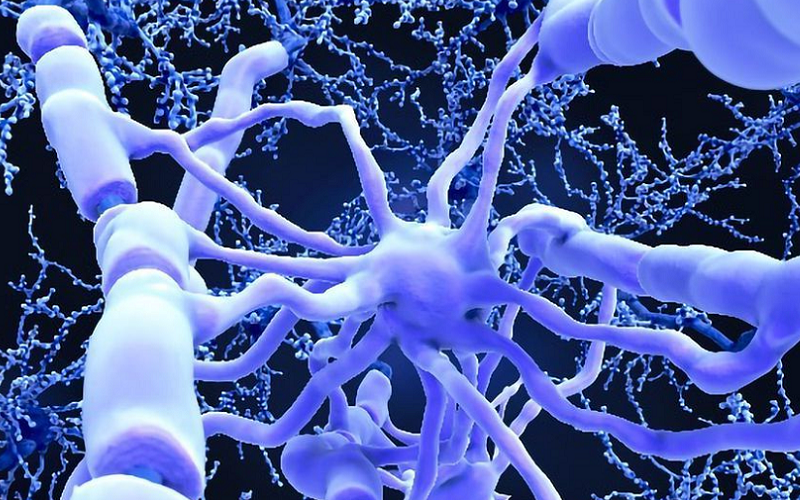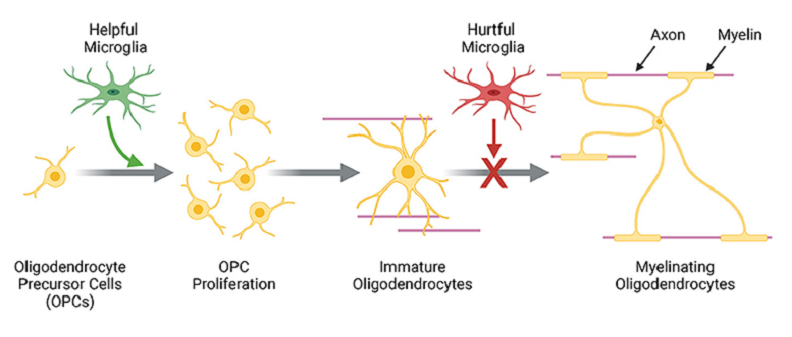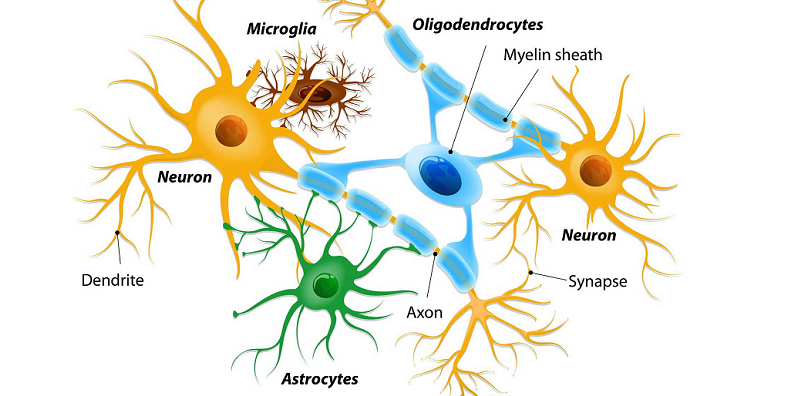
In the intricate tapestry of the human brain, each cell plays a pivotal role in maintaining cognitive functions and overall neural health. Among these cells, oligodendrocytes stand out for their unique and critical role in the nervous system. These lesser-known yet vital cells are responsible for the formation and maintenance of myelin, the protective sheath that envelopes nerve fibers, enhancing the speed and efficiency of electrical signal transmission in the brain.
Contents
Understanding Neurons and Myelination
Before diving into the specific role of oligodendrocytes, it’s essential to understand the broader context in which they operate. Here we explore the basic structure and function of neurons, the process of myelination, and why myelination is so crucial for neural health.
The Structure and Function of Neurons
Neurons, often referred to as the building blocks of the nervous system, are specialized cells designed to transmit information throughout the body. Each neuron consists of three main parts: the cell body (or soma), dendrites, and an axon. The cell body contains the nucleus and is responsible for maintaining the life of the cell. Dendrites branch out from the cell body and receive messages from other neurons, while the axon carries nerve impulses away from the cell body.
The primary function of neurons is to process and transmit information, a process that is facilitated by electrical and chemical signals. These signals allow neurons to communicate with each other and with other types of cells, creating a complex network that underlies all neural functions, from basic reflexes to complex cognitive processes.
The Process of Myelination
Myelination is a critical biological process where myelin sheaths, a type of insulating layer, are formed around the axons of neurons. This process is pivotal for the rapid and efficient transmission of electrical impulses along the nerve fiber. Myelin sheaths are made up of a substance called myelin, a white, fatty material that not only protects the axons but also speeds up the transmission of electrical signals.
The process of myelination is not uniform across the nervous system. It begins in the fetal stage and continues into early adulthood. Myelination is essential for the proper development of the nervous system and plays a key role in cognitive and motor skill development.
Importance of Myelination in Neural Health
Myelination is crucial for maintaining the speed and efficiency of neural communication. Without the insulating effect of the myelin sheath, nerve impulses would travel slowly or fail to transmit properly, leading to a range of neurological problems.
Proper myelination influences various aspects of neural health, including cognitive abilities like learning and memory, and motor skills like coordination and balance. Additionally, the integrity of myelin is a key factor in preventing neurological disorders. Diseases that affect myelination, such as Multiple Sclerosis, highlight the critical role myelination plays in overall neural health and functionality [1].

Oligodendrocytes: The Myelin Producers
Having understood the importance of neurons and myelination, we now turn our focus to oligodendrocytes. These specialized cells are the architects of myelination in the central nervous system (CNS).
Characteristics of Oligodendrocytes
Oligodendrocytes are a type of glial cell located in the CNS, which includes the brain and spinal cord. Unlike neurons, these cells do not transmit nerve impulses; instead, they play a supportive and protective role for neurons. One of the most distinctive features of oligodendrocytes is their ability to form myelin sheaths. They are smaller in size compared to neurons and have a unique appearance, characterized by their rounded cell body and multiple branching processes.
These processes extend to wrap around the axons of neurons, forming the myelin sheath. A single oligodendrocyte can myelinate multiple axons, unlike Schwann cells in the PNS, which can only myelinate a single axon segment. This structural capability underscores the efficiency and complexity of oligodendrocytes in the CNS.
The Mechanism of Myelin Formation
The process of myelin formation by oligodendrocytes is both intricate and critical for efficient nerve signal transmission. Oligodendrocytes produce myelin by extending their membrane processes to spiral around the axons. These layers compact tightly to form a dense, insulating sheath. This myelination process is not static; it continues to evolve throughout an individual’s life, adapting to the changing needs of the nervous system [2].
The composition of myelin is also notable. It is rich in lipids and proteins, which are essential for its insulating properties. The formation of myelin is a finely tuned process that requires a complex interplay of genetic and environmental factors. Disruptions in this process can lead to significant neurological impairments.
Differences Between CNS and PNS Myelination
While the fundamental purpose of myelination is consistent throughout the nervous system, there are notable differences in how myelination occurs in the CNS versus the PNS. In the CNS, as mentioned, a single oligodendrocyte can myelinate multiple axons. This contrasts with the PNS, where Schwann cells myelinate single axon segments.
The composition and structure of the myelin sheath vary between the two systems. The myelin in the CNS, produced by oligodendrocytes, is generally thinner and has different protein compositions compared to the PNS myelin produced by Schwann cells. These differences have significant implications for the repair and regeneration of myelin in diseases and injuries affecting the nervous system.
The Impact of Oligodendrocytes on Brain Function
Oligodendrocytes, through their role in myelination, exert a profound influence on the functioning of the brain. Here we explore how these cells enhance signal transmission, contribute to neural plasticity, and impact learning and memory.
Oligodendrocytes Enhance Signal Transmission
One of the most critical functions of oligodendrocytes is to facilitate the rapid and efficient transmission of electrical signals in the CNS. The myelin sheath created by oligodendrocytes wraps around axons, providing insulation that prevents signal leakage and increases the speed of nerve impulse conduction. This myelination enables neurons to transmit signals quickly and synchronously, which is crucial for all aspects of brain function, from simple reflexes to complex cognitive processes [3].
The speed of signal transmission in myelinated neurons can be up to 100 times faster than in unmyelinated neurons. This significant increase in speed is vital for the integration of information across different brain regions, allowing for coordinated and high-level functions such as decision making, response to stimuli, and motor coordination.
Role of Oligodendrocytes in Neural Plasticity
Neural plasticity refers to the brain’s ability to change and adapt in response to experience. Oligodendrocytes play a vital role in this process. Research has shown that myelination can be modulated based on neuronal activity, suggesting that oligodendrocytes contribute to the adaptive changes in the brain’s wiring.
This activity-dependent myelination is crucial for learning and adapting to new experiences. Changes in myelination can alter the strength and timing of neural signal transmission, which can affect the efficiency of neural networks. This adaptive capability of oligodendrocytes supports the brain’s ability to learn from the environment and form new memories.
Impact of Oligodendrocytes on Learning and Memory
Oligodendrocytes, through myelination, have a significant impact on cognitive functions, particularly learning and memory. Proper myelination is essential for the efficient communication between neurons in different brain regions, which is necessary for the consolidation and retrieval of memories.
Studies have shown that learning new skills can stimulate the production of new oligodendrocytes and the formation of new myelin. This process, in turn, supports the strengthening of neural circuits involved in learning and memory. Disorders that affect oligodendrocytes and myelination, such as multiple sclerosis, often result in cognitive impairments, further highlighting the importance of these cells in cognitive health.

Disorders Related to Oligodendrocytes Dysfunction
The health and functionality of oligodendrocytes are crucial for maintaining the integrity of myelin and, by extension, the proper functioning of the nervous system. When oligodendrocytes are damaged or dysfunctional, it can lead to several serious neurological disorders.
Multiple Sclerosis: A Case Study
Multiple sclerosis (MS) is perhaps the most well-known disorder associated with the dysfunction of oligodendrocytes. It is an autoimmune disease where the body’s immune system mistakenly attacks the myelin sheath in the CNS. This attack leads to demyelination, disrupting the efficient transmission of nerve impulses and resulting in a range of neurological symptoms [4].
Symptoms of MS can vary widely but often include fatigue, muscle weakness, difficulty with coordination and balance, and problems with vision. The progression of the disease can be unpredictable, with some individuals experiencing mild symptoms and others facing more severe and debilitating effects.
The exact cause of MS is still unknown, but it’s believed to involve a combination of genetic susceptibility and environmental factors. The disorder highlights the critical role of oligodendrocytes and myelin in maintaining neural function.
Other Myelin-Related Disorders
Multiple sclerosis is just one of several disorders that stem from oligodendrocyte dysfunction or myelin damage. Other notable conditions include the following.
Leukodystrophies
These are a group of rare, genetic disorders characterized by the abnormal development or destruction of myelin. They often manifest in early childhood and can lead to a decline in motor skills, muscle tone, and cognitive abilities.
Neuromyelitis Optica (NMO)
This condition is similar to MS but primarily affects the optic nerves and spinal cord. It leads to vision loss, muscle weakness, and paralysis.
Progressive Multifocal Leukoencephalopathy (PML)
A rare and often fatal viral disease that targets cells that produce myelin in the brain, leading to a rapid decline in cognitive and motor functions.
Current Research and Therapeutic Approaches
There is ongoing research aimed at understanding oligodendrocyte dysfunction and developing treatments for myelin-related disorders. Current therapeutic strategies for conditions like MS focus on managing symptoms, reducing the frequency of relapses, and slowing the progression of the disease. These treatments include immunosuppressive drugs, physical therapy, and lifestyle modifications.
One area of promising research is in remyelination therapies. Scientists are exploring ways to stimulate the body’s ability to repair damaged myelin or even to replace lost oligodendrocytes. Advances in stem cell research, gene therapy, and molecular biology offer hope for new treatments that can more directly address the underlying causes of myelin damage.
Promoting Healthy Oligodendrocytes
Given the vital role of oligodendrocytes in neural health, it’s essential to understand how we can support their functioning. Here we discuss various factors, including diet and lifestyle, and emerging neuroprotective therapies that can promote the health of oligodendrocytes and, consequently, the overall well-being of the nervous system.
Diet and Lifestyle Factors
Lifestyle choices can significantly impact the health of oligodendrocytes and the integrity of the myelin sheath. Nutrition plays a critical role in supporting these cells. Diets rich in omega-3 fatty acids, found in foods like fish, nuts, and seeds, are beneficial for maintaining myelin health. These fatty acids are integral components of myelin and can aid in the repair and regeneration of myelin sheaths [5].
Antioxidant-rich foods, such as fruits and vegetables, also support oligodendrocyte health by protecting these cells from oxidative stress, which can damage cell membranes and DNA. Regular physical exercise has been shown to enhance brain health and may also stimulate the production of new oligodendrocytes and the formation of myelin.
Avoiding harmful substances like excessive alcohol and certain drugs is also crucial. These substances can have detrimental effects on myelin and the overall health of the nervous system.
Advances in Neuroprotective Therapies
In addition to lifestyle modifications, there are advances in medical therapies focused on protecting and nurturing oligodendrocytes. One area of research is the development of drugs that can enhance the natural repair mechanisms of the body, including the regeneration of myelin.
Stem cell therapy is another promising avenue. This therapy aims to replace damaged oligodendrocytes or stimulate the body’s own stem cells to repair myelin. While still in the experimental stages, these treatments have shown potential in early clinical trials.
Neuroprotective medications that prevent damage to oligodendrocytes are also being explored. These drugs aim to protect these cells from harmful factors, such as inflammation or toxins, that can lead to demyelination.
Future Directions in Oligodendrocyte Research
The field of neurology is rapidly advancing, and with it, our understanding of oligodendrocytes and their role in brain health. Future research is likely to focus on better understanding the molecular mechanisms that regulate oligodendrocyte function and myelin formation. This knowledge could lead to the development of more targeted therapies for diseases like multiple sclerosis and other myelin-related disorders.
There is also a growing interest in the role of oligodendrocytes in aging and how changes in myelination affect cognitive function in the elderly. Exploring these areas could provide insights into how to maintain brain health throughout the lifespan.
References
[1] Oligodendrocytes: Myelination and Axonal Support
[2] Oligodendrocyte-mediated myelin plasticity and its role in neural synchronization
[3] Myelination-independent functions of oligodendrocyte precursor cells in health and disease
[4] Biology of Oligodendrocyte and Myelin in the Mammalian Central Nervous System
[5] Oligodendroglia: metabolic supporters of neurons

